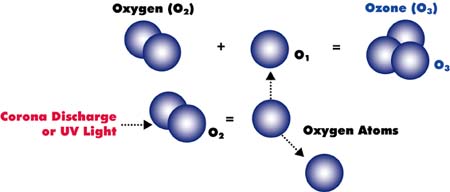|
|
|
|
|
|
|
|
|
|
|
|
|
|
|
 |
|
|
|
|
|
|
|
OZONE: Safe
for You. Safe for the Environment. |
|
|
|
|
|
|
What Is
Ozone?
- Ozone is "active oxygen", nature's special element. (Each ozone
molecule consists of three oxygen atoms.)
- Ozone is a natural purifier.
- Ozone is created in nature by the combination of oxygen in air
and the ultraviolet rays of the sun or by the corona discharge during a
lightning storm.
- Ozone has a clean, fresh scent noticed after a rainstorm.
- Ozone is the most powerful oxidizer safely used.
- Ozone is the alternative water purifier to traditional chemicals
such as chlorine and bromine.
What Does Ozone
Do?
- The Ozone layer in the atmosphere protects the earth from deadly
radiation.
- Ozone destroys bacteria, viruses, mold, and mildew.
- Ozone eliminates spores, cysts, yeast, and fungus.
- Ozone oxidizes iron, sulfur, manganese and hydrogen
sulfate.
- Ozone eliminates oils and other contaminants in water.
- Ozone eliminates odors in air, such as smoke.
- Ozone keeps water clean and sparkling clear.
- Ozone keeps water fresh.
Ozone Is
Healthy
- Ozone leaves no chemical by-products in water.
- Ozone leaves no chemical taste or smell.
- Ozone will not burn eyes or make them red or irritated.
- Ozone will not irritate or dry out skin, nose, or ears.
- Ozone will not leave a chemical film on material or skin.
- Ozone will not discolor or damage hair or clothing.
- Ozone adds no contaminants or by-products to water.
- Ozone rids water and air of unhealthy microorganisms.
- Ozone is NOT a carcinogen.
Where Is Ozone
Used?
- In 1906, Nice, France built the first water purification plant to
use ozone.
- Los Angeles, California has the largest ozone drinking water
treatment plant in the world.
- Most bottled water is purified by ozone.
- Ozone is used to clean waste water and toxic waste.
- Ozone purifies water in well and home drinking water
systems.
- Ozone systems have brought life back to "dead" contaminated lakes
and pools.
- Ozone is used to purify air in hotel rooms, boats, RVs, cars, and
smoke/fire damaged structures.
- Ozone is used in thousands of residential and commercial pools
and spas all over the world.
How Is Ozone
Made?

Ozone Is Safe for
the Environment as well as Equipment
- Ozone will not explode.
- Ozone is not a fire hazard.
- In the dose required for excellent purification, ozone does not
produce harmful fumes.
- Ozone will not damage plumbing fittings or pipes.
Ozone Is
Convenient in Pools and Spas
- Ozone does not have to be purchased or stored. Ozone is generated
?on site? and is introduced into the water or air automatically.
- Ozone does not affect the pH balance of water, thus minimizing pH
adjustments.
- Ozone helps reduce total dissolved solids in water so that the
water does not have to be changed as often.
- Ozone eliminates much of the routine maintenance because it does
such an effective job keeping the water clean.
Information About Chloramines
When any type of chlorine is added to water, it usually forms
hypochlorous acid (HOCl - the most powerful killing form of chlorine in
water) and hypochlorite ion (OCl-), a relatively weak form of
chlorine in water. The percentage of HOCl and OCl- is determined by the pH
of the water. As the pH goes up, less of the chlorine is in the killing
form and more of the chlorine is in the weaker form. The total of HOCl and
OCl- is the free available chlorine.
Chlorine can
combine with ammonia and nitrogen compounds in the water to form
chloramines, sometimes called combined chlorine. By combining with ammonia
and nitrogen, free chlorine in the water is disabled. Chloramines are 60
to 80 times less effective than free chlorine. Chloramines are formed any
time ammonia and nitrogen are in the water. Some of the ammonia and
nitrogen compounds are introduced into the water by swimmers and bathers
in the form of perspiration, urine, saliva, sputum and fecal matter. An
active swimmer sweats one pint per hour. The average person sweats three
pints per hour in a heated spa. Ammonia and nitrogen compounds are also
introduced into the water by rain. Each drop of rain has some dissolved
nitrogen from our atmosphere and from automobile
emissions.
Chloramines smell bad. This is the smell most often
associated with pools and spas in health clubs and YMCAs. Chloramines are
eye and skin irritants, and they cloud the water.
Chloramines can
be removed from the water by the following three methods:
- By adding a mega-dose of chlorine. Usually 3 to 6 times more
chlorine than a normal dose is added to the water, or the level of
chlorine is raised to 5 to 10 ppm and held there for 4 hours. This is
called superchlorination. To remove chloramines, the ratio of chlorine
to ammonia must be at least 7.6 to 1. If this ratio is not obtained,
then more chloramines will be produced. Swimmers and bathers should not
enter the water until the level of chlorine has dropped to 3 ppm or
less.
- By adding a non-chlorine shock to the water. The most common
chemical used for this is potassium peroxymonosulfate. This ?shocking?
requires the addition of one pound of shock for each 10,000 gallons of
pool water.
- By adding ozone to the water. If an ozone generator is installed
on a pool or spa, then oxidation of the ammonia and nitrogen compounds
will take place whenever the ozone system is operating. The longer the
system operates, the more the ozone can destroy the ammonia and
nitrogen. Although most ozone systems operate only when the pool or spa
pump is operating, there are 24-hour systems available which will
continously oxidize ammonia and nitrogen as they enter the
water.
Ozone oxidizes soap, deodorant, hair spray, cologne, makeup,
perfume, body lotion, hand cream, sun tan lotion, saliva and urine. In
addition, ozone kills all pathogenic bacteria, germs and viruses. Ozone
takes care of the big job of oxidizing all these organic contaminants.
Ozone frees up the combined chlorine, thus leaving the chlorine free to
provide a residual. Ozone ultimately enhances the performance of chlorine
and bromine.
Less chlorine or bromine will be needed to maintain a
residual. Commonly, ozone reduces chlorine or bromine use by 60-90
percent. The quality of water will be dramatically better with the
combination of ozone and chlorine or the combination of ozone and bromine
than with chlorine and bromine alone.
Frequently Asked Questions About Ozone
- What is Ozone?
Ozone is active oxygen, O3.
It occurs naturally in the earth's atmosphere to protect us from the
sun's harmful rays.
- What are some uses of ozone?
Some common uses are: pool
and spa water purification, drinking water purification, waste water
purification, and air freshening.
- How long has ozone been used to purify water?
Since the
late 1800's.
- How long has ozone been used to purify pool and spa water and
remove odors from the air?
Over 50 years.
- How does the ozone used for water purification affect the air
we breathe?
The amount of ozone produced by an ozone generator is
insignificant to the normal atmosphere we live in. When dissolved in
water, ozone is extremely safe. Excess ozone quickly converts back to
oxygen. Note: do not breathe concentrated ozone gas.
- Is ozone the same as "SMOG"?
No! "Smog" is air
pollution created by combustion polluters. While smog contains small
amounts of ozone, it is largely composed of harmful chemicals such as
carbon monoxide. In fact, smog and other pollutants may contribute to
the damage of the ozone layer.
- If I use ozone in my pool or spa, will I help replenish the
ozone layer?
No. Because ozone reacts so quickly with
contaminants in water and air, it converts back to oxygen within minutes
or even seconds. Any ozone molecules that break free from the pool or
spa water will convert to oxygen and never reach the
atmosphere.
- Will ozone hurt me?
No! In the quantities necessary to
be effective, ozone is very gentle to humans and equipment in the water.
However, you should never breathe concentrated ozone gas.
- Does ozone have an odor?
Yes. Depending on the
concentration, the odor ranges from slightly sweet to moderately
antiseptic.
- Will ozone kill bacteria?
Yes. It is one of the most
effective, complete bactericides of all earth?s measurable
elements.
- Will ozone kill viruses?
Yes. Ozone kills virtually all
known forms of viruses in water and air.
- How is ozone different from chlorine?
In the quantities
needed for water purification, it has no noticeable odor, taste or
color. It is not irritating to humans or equipment. Ozone purifies water
and air very quickly and efficiently, 3,000 times faster than chlorine.
Ozone leaves no by-products except pure oxygen. In contrast, chlorine
leaves a chemical by-product called hypochloric acid and additional
salts in water applications.
- Will Ozone reduce scum lines and foaming in spas?
Yes.
With proper filtration it should completely eliminate them.
- How is ozone produced?
Ozone can be produced by
ultraviolet (UV) light or by corona discharge (CD).
- How does ultraviolet light ozone generation work?
A
special lamp gives off a specific wavelength of ultraviolet light which
converts oxygen (O2) molecules into ozone (O3)
molecules by splitting the oxygen molecules into individual oxygen atoms
(O1) which then recombine with oxygen molecules to form
ozone. This all occurs instantly inside the ozone chamber in the ozone
generator.
- How does Corona Discharge Ozone Generation work?
Ozone
is produced by passing air through a high voltage electrical discharge,
or corona. A minimum of 5,000 volts of electricity is necessary to
create the corona. Air or concentrated oxygen dried to a minimum of
-60°C dewpoint passes through the corona which causes the O2
bond to split, freeing two O1 atoms which then collide with
other O2 molecules to create ozone. The ozone/gas mixture
discharged from the CD ozone generator normally contains from 1% to 3%
ozone when using dry air, and from 3% to 6% ozone when using high purity
oxygen as the feed gas.
- Can ozone damage my pool or spa equipment?
No. In fact,
it is very gentle to spas, pools, and equipment. Applied properly, ozone
is more gentle than any other water purifier in existence.
- Can the ozone in my pool irritate skin or eyes like chlorine
in pools?
No! Ozone is very gentle to skin and eyes.
- How long will ozone last in my pool or spa
water?
Scientific theory states that Ozone has a half life of
about 22 minutes in water. In residential applications, ozone reverts
back to oxygen in minutes (ozone breaks down faster in warmer
water).
- Will water temperature affect ozone?
Wide variations in
pool water temperature will affect how well ozone works. An ozone
generator should be designed and sized for maximum water temperatures
and bather load.
- Will ozone affect my pH?
Ozone is pH neutral. It will
not adversely affect the pH.
- Do I still have to filter the water as often?
Yes.
Because impurities are constantly being introduced into the water and
the ozone is constantly destroying them, the microscopic remains will
need to be filtered out of the water.
|
|
|
|
|
|
|
|
Send mail
to o3info@delozone.com
with questions
or comments about this web site.
Copyright © 2000 DEL Industries, Inc.
All rights reserved. |
| |

